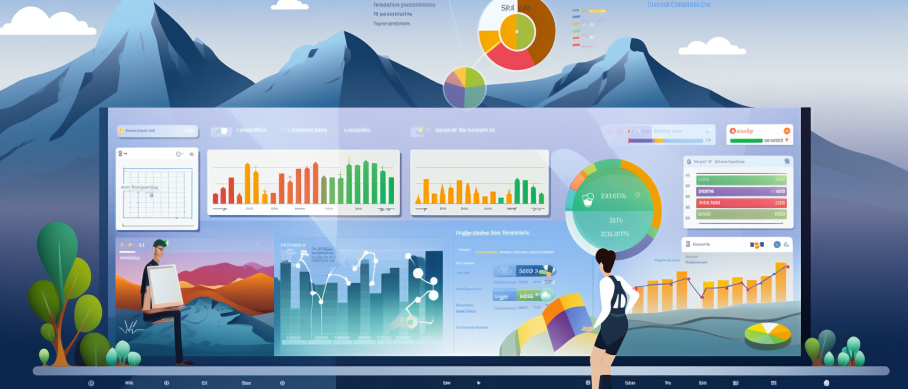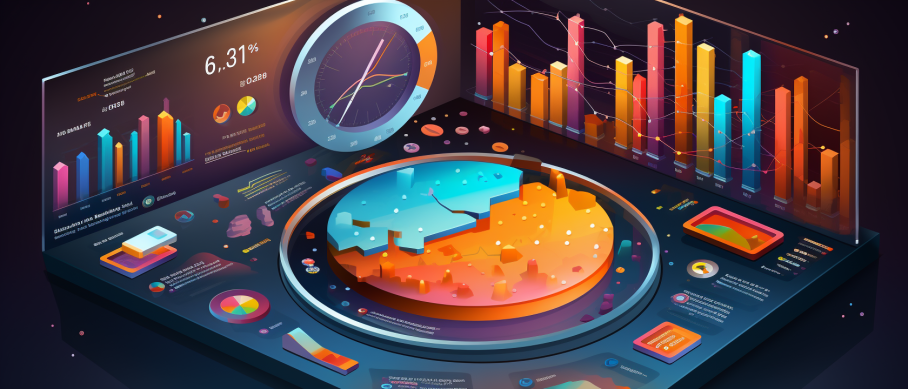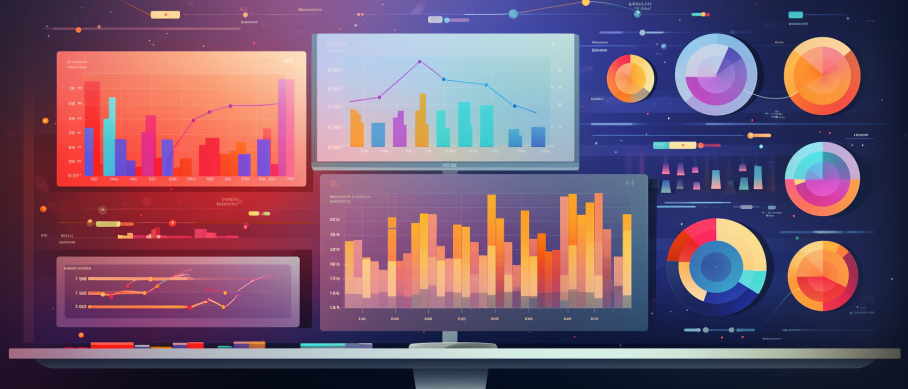Key Takeaways
✅ Align Metrics with Organizational Priorities: When it comes to performance, not all numbers are created equal. By honing in on metrics that echo your business's core aims, you can dodge the distraction of irrelevant data. Recent stats highlight that companies focused on strategic key performance indicators (KPIs) can see growth rates up to 3x those who don't. Ensuring each metric tells a story aligned with your end goals lays down a clear track for success.
✅ Communicate Effectively: Remember, even the most profound insights are useless if they're stuck in jargon-ville. The art of reporting is not just in the numbers but in storytelling – shaping complex data into engaging and understandable plots. Organizations with effective data communication strategies are 1.7 times more likely to outperform their competitors. Transparency and clarity in sharing these insights foster trust and smart decision-making across your team.
✅ Synthesize Data into Simple Takeaways: In a world drowning in data, the winners are those who offer a lifeline of simplicity. Turning dense data into crisp conclusions removes the fluff and focuses on what's actionable. Businesses that effectively distill data into key insights see a 20% improvement in team alignment and decision-making efficiency. Balance your reporting with simplicity and depth to ensure every number has a narrative.
![]()
Introduction
Have you ever felt tangled in a web of spreadsheets and reports, knowing there's value there but not sure how to extract it? Improving Reporting with Performance Tracking and Key Metrics is akin to finding the map that leads you out of the numbers maze. In today's world, using data-driven insights isn't just useful; it's what separates thriving businesses from the ones that only tread water. No matter the tide of market trends or the winds of industry change, a solid grasp on your performance metrics is your business's guiding star.
The promise of Performance Tracking is clear: to pivot from gut feelings to informed strategies that maximize revenue and ROI. But how does one go from logging numbers to leading with them? This article peels back the curtain on this critical business process, providing a trove of straightforward insights. Through our exploration, we'll equip you with effective decision-making tools, modern trends in metric management, and solutions to enhance reporting practices that keep your business sailing smoothly toward its objectives. Stay tuned, as we're about to unveil those actionable insights that could very well become the turning point for your business success.
Top Statistics
| Statistic | Insight |
|---|---|
| Visual Elements: Charts and graphs significantly enhance the engagement and comprehension of performance reports. | Making reports visually appealing not only draws attention but also eases the understanding of complex data. |
| Data-Driven Decision-Making: Prioritizing metrics leads to informed decisions that better reflect employee performance and business outcomes. | Emphasizing the right metrics ensures that decisions are anchored in reality and are more likely to yield positive results. |
| Reduce Data Points: Streamlining data points leads to quicker data transactions and more efficient report rendering. | Simplification can effectively improve processing times and user experience, making the information more actionable. |
| HR Software Utilization: Leveraging technology for analytics, such as HR dashboards, simplifies the tracking of human resource metrics. | Harnessing the right tools can streamline the monitoring process, offering a clearer picture of workforce dynamics. |
| Regular Review Sessions: Consistent meetings to analyze reports keep teams informed and coordinated towards common goals. | Frequent discussions foster a sense of accountability and collective direction, improving the team's focus and morale. |
Importance of Performance Tracking and Key Metrics
Have you ever wondered how businesses determine whether they're on the right path to success? Performance tracking and key metrics play a critical role in this process, acting as the navigational instruments for the business journey. They're vital because they allow companies to measure progress against their goals and identify opportunities for improvement. This is about more than just numbers on a spreadsheet; it’s about understanding what drives success and getting concrete evidence of how initiatives perform. It's similar to a doctor using vital signs to gauge a patient's health; businesses use key metrics to monitor their vitality.
Understanding Key Performance Metrics (KPIs)
Key Performance Indicators (KPIs) are the beacon lights that guide businesses through the dark waters of market uncertainty. But what are KPIs exactly? They're measurable values that show how effectively a company is achieving its business objectives. For example, retail businesses often look at same-store sales to gauge growth, while subscription-based services might focus on churn rate – the rate at which customers cancel their subscriptions. The idea is to choose KPIs that resonate with your business's heartbeat, providing insights that align with your specific goals and strategic direction.
Setting Up a Performance Tracking System
Laying the groundwork for a performance tracking system involves a few critical steps. To start, you'll need to identify what you want to track and establish a baseline. Next, you'll look for tools and software that handle data tracking and analysis—a bevy of options awaits, from Google Analytics for website traffic to more specialized tools like Salesforce for customer relationship management. Remember that consistency is key for meaningful data, along with ensuring your tools are properly integrated for seamless data collection. This allows you to have a comprehensive view of performance across various facets of your business.
Choosing the Right Key Metrics
When selecting key metrics, it's important to differentiate between quantitative metrics, which are numerical and easy to measure (like click-through rates), and qualitative metrics, which are more about quality and customer satisfaction. Furthermore, leading indicators can predict future performance, while lagging indicators provide insights after an activity is completed. What metrics should you watch? Sales teams often track new leads per month, while marketing may look at social media engagement. The trick here is to match metrics closely with your company's objectives and operational focus.
Analyzing and Interpreting Performance Data
The act of analyzing performance data is akin to a detective interpreting clues. It involves using various methods for visualizing data, such as charts and graphs, which can help in spotting trends and patterns. But drowning in data without spotting the connections is a common pitfall. Techniques like correlation analysis can reveal relationships between variables—imagine discovering that an increase in customer service training correlates with a decrease in complaints. These insights are what empower businesses to make informed decisions.
Implementing Data-Driven Decision-Making
Finally, to make data-driven decision-making a cornerstone of your business strategy, it must be woven into the fabric of the organizational culture. This means not only equipping teams with data but also ensuring everyone understands how to use it. Open lines of communication ensure that performance insights reach all stakeholders, making sure that data isn't just a buzzword but a daily tool for improvement. By deeply embedding this approach, any business can evolve, making well-informed tweaks that continuously enhance performance and drive growth.
AI Marketing Engineers Recommendation
Recommendation 1: Embrace Custom Dashboard Solutions for Real-Time Insights: To make data-driven decisions, businesses must see the big picture, which is where custom dashboards come in. By utilizing tools like Google Data Studio or Tableau, companies can combine data from various sources to monitor metrics that matter in real-time. For instance, a retail business could integrate point-of-sale system data with web analytics to see which products are gaining online traction and resulting in sales. Reports indicate that organizations that use visual data discovery are 28% more likely to find timely information than those that don't - a compelling reason to adopt this approach (Gartner).
Recommendation 2: Prioritize Metrics Linked Directly to Business Goals: It's no secret that key performance indicators (KPIs) should align with overall business objectives. However, trends show a shift towards even more tailored KPIs that reflect strategic priorities. For example, if a company aims to boost online engagement, focusing on metrics like session duration and page views won't suffice. Instead, deeper engagement metrics like scroll depth and interactions per visit are necessary. Companies that align their marketing KPIs closely with their strategic goals tend to have 72% more success in achieving their business outcomes (Forbes).
Recommendation 3: Invest in Predictive Analytics for Forecasting Future Trends: The use of Predictive Analytics is becoming a game changer for marketers. By leveraging tools such as IBM Watson or Adobe Analytics, businesses can move beyond historical data to anticipate customer behaviors and market shifts. This kind of predictive power ensures better allocation of marketing resources to areas with the highest potential return. Retailers utilizing predictive analytics can, for instance, accurately plan inventory based on predicted consumer trends, often resulting in a 50% reduction in inventory holding costs and a 10-20% increase in sales (IBM).
Relevant Links
- Learn the key tactics for conquering China's digital retail space.
- Discover how to measure PPC success in China's unique advertising landscape.
- Strategies for forging successful brand partnerships with Korean influencers.
- Essential guide for international brands eying Japan's thriving online market.
- Revolutionize your online presence with cutting-edge SEO strategies.
Conclusion
In the landscape of today's fast-paced business environment, improving reporting with performance tracking and key metrics is not just beneficial; it's essential. The core of this approach lies in the accurate tracking of performance against well-defined Key Performance Indicators (KPIs). These indicators serve as a compass, guiding companies towards their strategic goals while also shedding light on areas needing attention. With the right KPIs, businesses can pivot from gut-driven decisions to data-led strategies, a move that can distinguish a thriving business from a struggling one.
However, identifying the right KPPs is only the beginning. Implementation of a robust tracking system using the appropriate tools and software is equally fundamental. With an effective system in place, deciphering the stories that data tells becomes possible, allowing us to translate complex data sets into actionable insights. Crucially, integrating these insights into your organization can foster a culture of continuous improvement and optimization. By doing so, companies can enhance decision-making, streamline operations, and improve their bottom line—outcomes that every business aspires to achieve.
Remember, the truth lies in the numbers. As we reflect on the benefits of using data-driven insights, it is clear that the effort invested in setting up and maintaining a performance tracking system can lead to significant rewards. More informed decisions and a clearer vision for the future are just a couple of the powerful advantages such a system can unlock. So as you step into your next business cycle, think about how you can leverage performance tracking and key metrics to steer your company towards success. Will your next big decision be backed by data, or will you be navigating in the dark?
FAQs
Question 1: What are Key Performance Indicators (KPIs)?
Answer: KPIs are the most critical performance indicators for a business at the highest level. They're like the vital signs of a company, letting you know if you're healthy and on track to meet your big-picture goals.
Question 2: Why are KPIs important?
Answer: KPIs are super important because they're like a compass for your business—they guide you in the right direction and help you make smart, informed decisions based on data, not just gut feelings.
Question 3: What is KPI tracking?
Answer: Think of KPI tracking as taking your business's pulse regularly. It's about keeping an eye on those vital signs, comparing them against your goals, and using the insights to tweak your strategy.
Question 4: What is KPI reporting?
Answer: KPI reporting is all about telling the story of your data. You pull together all the numbers, make sense of them, and create a snapshot that helps you and others understand what's happening and what should happen next.
Question 5: How do I choose the right KPIs?
Answer: Choosing the right KPIs is a bit like choosing ingredients for a recipe—you want only the ones that will really enhance the dish, or in this case, ones that match your business goals and give you meaningful insights.
Question 6: What tools can I use for KPI tracking and reporting?
Answer: There's a toolshed full of gadgets and gizmos out there for KPI tracking and reporting. Tools like ClearPoint Strategy, Improvado, and others that bring real-time data, visuals, and automation into your hands.
Question 7: How do I create effective KPI dashboards?
Answer: Effective KPI dashboards are like art galleries for your data. They display all your metrics in one place, using colors and shapes (charts and graphs!) to make the data easy to digest and act upon.
Question 8:Why is cross-functional collaboration important for KPI optimization?
Answer: Cross-functional collaboration breaks down walls between departments. It's important because it gets everyone rowing in the same direction, aiming for the same targets, and it makes your business run smoother.
Question 9: How do I implement KPI tracking effectively?
Answer: To implement KPI tracking effectively, you need a solid game plan, the right tools, and a commitment to keeping an eye on those KPIs. Communication across teams is key to ensure everyone knows the score and what they're aiming for.
Question 10: How do I avoid common pitfalls in KPI reporting?
Answer: Steering clear of pitfalls in KPI reporting is like avoiding potholes on a road. Don't get distracted by flashy but meaningless metrics, and make sure everyone's on board with the KPIs you've chosen.
Academic References
- Effective Communication for Performance Metrics Monitoring. This study emphasizes the importance of communication channels between leaders and employees in the monitoring of performance metrics, promoting an environment where information flow is crucial for success.
- Aligning KPIs with Strategic Objectives. This reference highlights the importance of linking key performance indicators directly with a company's strategic goals to ensure each metric has a purpose and contributes to the overall vision and direction of the organization.
- Stakeholder Buy-in for Performance Management. Reveals the need for engaging executives and stakeholders in performance management, creating a shared understanding of objectives, and building a data-informed culture within the organization.
- KPI Reporting for Business Improvement. Discusses how monitoring key performance indicators can shed light on progress towards objectives, pinpoint areas that need work, and inspire initiatives that lead to organizational successes.
- Best Practices for KPI Tracking. Explores strategies for effective Key Performance Indicator tracking, which includes choosing the right metrics, employing suitable tools, consistent monitoring, goal alignment, and prioritizing clear communication.
- HR Metrics Tracking and Reporting. Argues for the critical role that HR metrics play in organizational success, recommending strategic alignment with the company's priorities, focusing on impactful metrics, and using HR analytics software to aid in decision-making.
- KPI Optimization through Strategic Metrics Selection. Suggests that careful selection and regular monitoring of KPIs can reveal important trends and opportunities for improvement, which is vital for achieving the best outcomes for the company.










